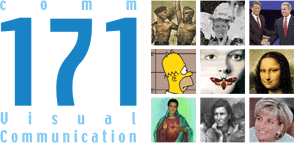
Office: HGH 210; phone: (408) 924-5378
Email: wooda@email.sjsu.edu
Web: http://www.sjsu.edu/faculty/wooda
 |
Dr. Andrew Wood Office: HGH 210; phone: (408) 924-5378 Email: wooda@email.sjsu.edu Web: http://www.sjsu.edu/faculty/wooda |
Reading:
Sturken, M, & Cartwright, L. (2001). Practices of looking: An introduction to visual culture. New York: Oxford University Press.
| Note: These comments are not designed to "summarize" the reading. Rather, they are available to highlight key ideas that will emerge in our classroom discussion. As always, it's best to read the original text to gain full value from the course. |
 Recall
the 1981 film Raiders of the Lost Ark. Visualize handsome and daring
Indiana Jones as he slings his bullwhip against all manner of exotic foes in
an effort to steal cultural artifacts. In one famous scene, a man with Arab
appearance threatens Jones with a daring display of swordsmanship, tossing and
flipping his ancient weapon from hand to hand. Tired and somewhat bored, Jones
draws his gun and shoots the man dead. What does it mean to watch this film,
to imagine yourself in the complicated role of the hero? When you watch movies
like Raiders or films from the James Bond series, do you picture yourself
as the hero, or do you watch the movie more passively? Some theorists of visual
communication suggest that our likely response to such spectacle, an interpellation
of ourselves into the idealized subject, reflects important statements about
power at multiple levels.
Recall
the 1981 film Raiders of the Lost Ark. Visualize handsome and daring
Indiana Jones as he slings his bullwhip against all manner of exotic foes in
an effort to steal cultural artifacts. In one famous scene, a man with Arab
appearance threatens Jones with a daring display of swordsmanship, tossing and
flipping his ancient weapon from hand to hand. Tired and somewhat bored, Jones
draws his gun and shoots the man dead. What does it mean to watch this film,
to imagine yourself in the complicated role of the hero? When you watch movies
like Raiders or films from the James Bond series, do you picture yourself
as the hero, or do you watch the movie more passively? Some theorists of visual
communication suggest that our likely response to such spectacle, an interpellation
of ourselves into the idealized subject, reflects important statements about
power at multiple levels.
Chapter Three (pp. 72-108) explores the notion of spectatorship, proposing that texts (visual or otherwise) evoke an idealized subject, not an actual person. These texts invite us to suspend our individual perspectives and adopt the ideal persona imagined by those who shape the texts. Thus, while a person might walk into a theater simply to enjoy a movie, the scene invites the person to "become" the idealized subject through a process of fantasy and even infantile regression. The authors provide an initial explanation of this process through the use of Jacques Lacan's psychoanalytic theories of spectatorship in which persons (identified by Lacan as "subjects") define themselves through the contrasts they see between themselves and idealized others, a process first experienced by infants. Texts such as films that simulate that infantile "mirror phase" possess great power to invoke otherwise repressed emotions buried within the subconscious.
The authors also employ feminist readings of psychoanalytic theory to argue that the spectator - the idealized persona who encounters the image - can be viewed as possessing a certain gaze: a sensualized (often sexualized) process of looking that often assumes a male subject. The notion of male gaze reveals the social and economic process that shapes various forms of art, proposing for example that a painting of a nude woman may be crafted to fulfill the fantasies of the male spectator. Though the act of viewing without consequence, the male spectator experiences a sense of power over the woman and, potentially, over all women. Even so, this experience often requires the spectator to sacrifice a measure of agency himself, such as when a subject sits in a darkened room to view the image. Lately the notion of gaze has become more nuanced as feminist theorists explore the female gaze. Even pornography, apparently the exemplar of male gaze, becomes complicated when some feminist artists, critics, and scholars appropriate this gaze for their own purposes. Indeed, the binary notion that one gender gazes upon another loses its validity when one considers the myriad forms of subject position (such as racial and/or sexual orientation) which emerge in contemporary media settings.
One might imagine how images serve to reproduce larger fields of force. Consider the feeling you get when walking into a store beneath the lens of a video camera. Surveyed and categorized, you might imagine yourself as subject to disciplinary gaze, a potential criminal. To explore the technology of this gaze, the authors introduce Michel Foucault's concept of discourse: the rules and practices which enact certain subjects and ways of knowing about them. Noting how technologies such as photography employ institutional gaze to construct "others," Foucault describes how those deviant and potentially dangerous individuals and groups must be observed carefully. Not only are we often sorted according to these photographic categories, the authors note who we compare ourselves to photographic images, adopting poses that mirror what we see. After all, the power of the modern state emerges not from coercion but from cooperation as subjects learn to discipline their bodies to institutional ends. "Documentary" photos and stylized images often serve this purpose. Ultimately, Foucault's invocation of Jeremy Benthem's panopticon ("all seeing place") illustrates the goal of this process when subjects come to discipline themselves without necessarily being observed.

The authors conclude this chapter by noting how the institutional construction of exotic others - analyzed through the evaluation of binaries such as civilization/nature - serves to affirm dominant interests which are typically male, white, and wealthy. They cite Edward Said who explores the role of Orientalism as a necessary counterpoint to European power. Surely, Indiana Jones' exploits throughout the Orient remind critics of the idealized white colonial subject who employs (and destroys) exotic "others" for selfish ends. Moreover, as this photograph from the 1893 Columbian Exposition illustrates, the construction of civilization seems to require a marked "other," a clear delineation between that which is civilized and that which is not. Observe how women stand in unmoving surveillance while Samoans serve as objects of an ethnographic exhibit. Judging by the comparative dress of the groups - the women in Victorian finery, the Samoans practically nude - one might imagine a sophisticated ideology of labor, fashion, and mobility which affirms the power of those who planned the fair and defines the impotence of those who served it. Can you imagine yourself as a tourist in an exotic site, a South Seas island, perhaps? What stories do your photographs really tell?
Activity
Select a film such as Silence of the Lambs that features various types of gaze. Identify the various forms of gaze in a specific scene. Which one seems to dominate?
Off-campus webpages
Clare O'Farrell's Michel Foucualt resources <http://www.qut.edu.au/edu/cpol/foucault/>
Note: These pages exist outside of San Jose State University servers and their content is not endorsed by the page maintainer or any other university entity. These pages have been selected because they may provide some guidance or insight into the issues discussed in class. Because one can never step into the same electronic river twice, the pages may or may not be available when you request them. If you have any questions or suggestions, please email Dr. Andrew Wood.